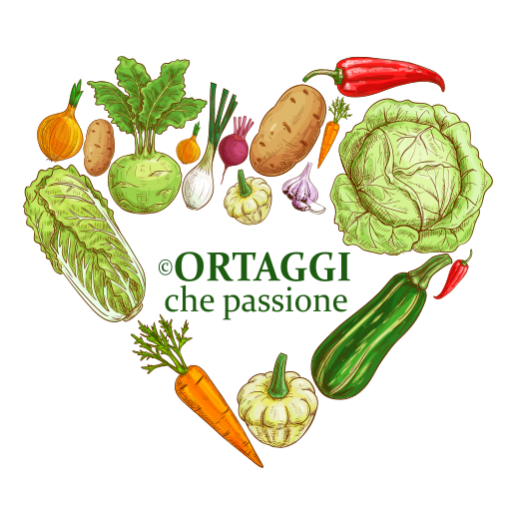Discover the recipe to make the homemade St. Martin’s cake, with all the steps to create the traditional decorated cookie. In Venice, the St. Martin’s cake (also called St. Martin’s Mantle) is prepared to celebrate November 11th, one of the most traditional folk festivals of the lagoon. To learn about its history, read at the end of the article. In November, you can already find it ready and decorated for sale in bakeries, pastry shops, and supermarkets in Veneto and some of its provinces like Padua and Treviso.
You can choose to print the drawing, the sketch, or the paper pattern to prepare your St. Martin’s cookie at home or you can buy the mold online: small – medium – large.
SHORTCRUST pastry RECIPES
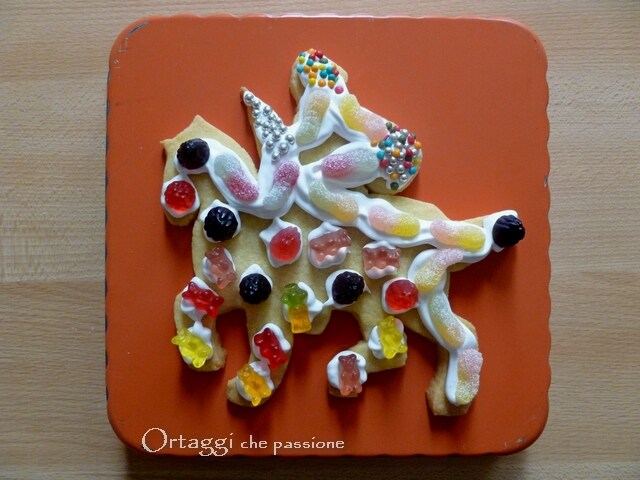
- Difficulty: Medium
- Cost: Economical
- Rest time: 10 Minutes
- Preparation time: 45 Minutes
- Portions: serves 2-3 St. Martin's cakes
- Cooking methods: Oven
- Cuisine: Italian
- Seasonality: St. Martin
- Energy 597.41 (Kcal)
- Carbohydrates 72.76 (g) of which sugars 24.22 (g)
- Proteins 8.63 (g)
- Fat 31.90 (g) of which saturated 20.13 (g)of which unsaturated 11.36 (g)
- Fibers 1.53 (g)
- Sodium 6.74 (mg)
Indicative values for a portion of 100 g processed in an automated way starting from the nutritional information available on the CREA* and FoodData Central** databases. It is not food and / or nutritional advice.
* CREATES Food and Nutrition Research Center: https://www.crea.gov.it/alimenti-e-nutrizione https://www.alimentinutrizione.it ** U.S. Department of Agriculture, Agricultural Research Service. FoodData Central, 2019. https://fdc.nal.usda.gov
St. Martin’s Cake – the traditional horse
You can use your favorite shortcrust pastry recipe (even vegan or gluten-free or lactose-free), prepare it by hand, with a stand mixer or with the thermomix.
Do not use baking powder to avoid the shortcrust pastry puffing up and losing its nice defined shape.
For a harder cookie base, bake the shortcrust pastry for longer.
- 9 tbsp butter (soft)
- 2 cups all-purpose flour
- 1/3 cup sugar
- 1 egg yolk
Tools
If you don’t have the mold, you can purchase it online small – medium – large.
Or make it at home with the drawing, the sketch, or the paper pattern to print.
- 1 sheet of A4 paper
- Marker
- Scissors
- Bowl
- Plastic wrap
- Rolling pin
- Parchment paper
- Knife with a pointed tip (well-sharpened)
St. Martin’s Cake
TUTORIAL to create the homemade mold
First of all, create the paper mold of the Saint on horseback shape:
1) for the one on the left, I drew freehand on a sheet
2) for the one on the right, I used this paper pattern
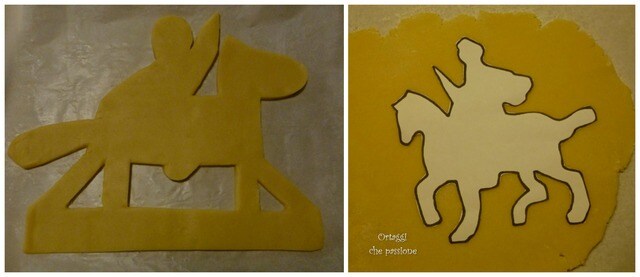
Prepare the SHORTCRUST PASTRY
Put in a bowl: the soft butter in pieces (9 tbsp), the flour (2 cups), the sugar (1/3 cup), and the egg yolk.
Set aside the egg white as it will be used for the decorative glaze, or you can freeze it.
Work the dough with your fingertips until the mixture becomes uniformly sandy in texture and color.
If the shortcrust pastry is too soft, add some flour; if too hard, add some cold water.
Create a homogeneous ball and cover it with plastic wrap, place it in the refrigerator for at least 30 minutes or in the freezer for 10 minutes.
After the time, roll out the shortcrust pastry on a sheet of parchment paper (or a silicone baking mat) to about 1/4 inch, place the paper pattern on top and cut out the edges with the tip of a sharp knife.
BAKING
Bake the base of St. Martin in a preheated static oven at 356°F for 15 – 20 minutes or until the edges of the cookie start to color slightly and the cookie is still soft. Remove immediately from the oven, it will solidify as it cools.
Handle the cookie with care both before and after baking, this type of shape is very fragile.
DECORATE AS DESIRED
For inspiration, look at photos of decorated St. Martin’s cakes.
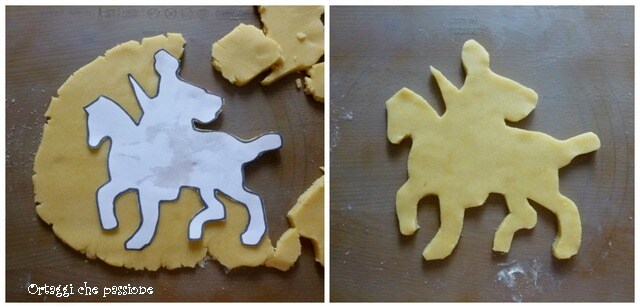
How to decorate the St. Martin’s cake?
I decorated the cookie with a soft royal icing. Prepared with egg white and sifted powdered sugar (4 times the weight of the egg white). First, I whipped the egg white to stiff peaks, then added the powdered sugar little by little, always mixing at the highest speed with the stand mixer. If desired, the glaze can be colored with powdered food coloring,
Then, with a piping bag, I decorated the St. Martin and placed the candies on top; after a few hours, the royal icing dried.
Alternatively:
– melt some chocolate (white, milk, or dark) in a bain-marie (or microwave) and pour it over the cookie to use it as “glue” for the candies
– buy some ready-made cake glaze
List of CANDIES and SWEETS to decorate St. Martin
Amaretti, chocolates, gummy candies, jelly candies, sugar sprinkles, colored almonds, almond brittle, candied fruit, dried fruit (almonds, hazelnuts, hazelnuts, pine nuts, pistachios), jellies, marshmallows, mini meringues, silver pearls, licorice wheels, smarties, colored sugars.
How to decorate the St. Martin before baking?
Garnish the raw shortcrust pastry with heat-resistant candies (smarties) and dried fruit.
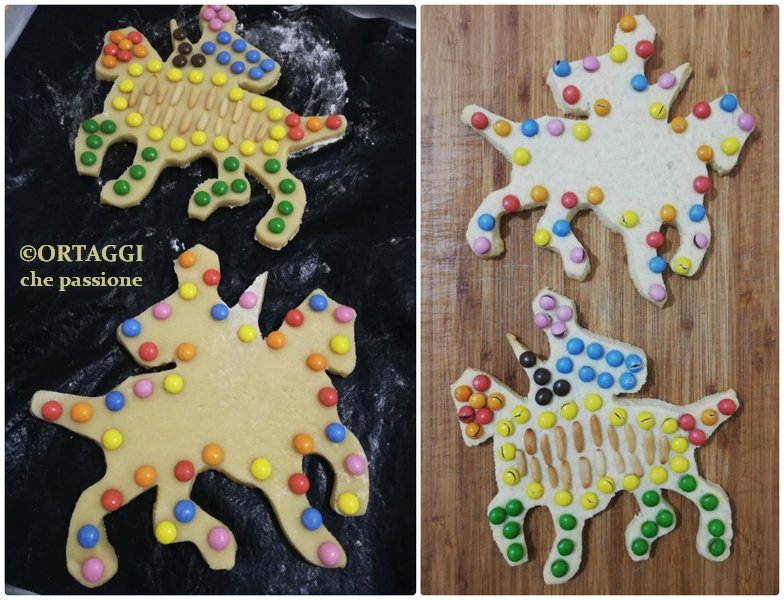
St. Martin’s Day in Venice
In Venice on November 11th, groups of children (often with a cloak on their shoulders and a paper crown on their heads) beat wooden spoons on pots and lids to make noise and sing this nursery rhyme until they receive sweets as a gift.
San Martin xè andà in sofita
par trovar la so noviza;
so noviza no ghe giera,
San Martin xè andà par tera.
E col nostro sachetin,
ve cantemo el San Martin.
Su ‘sta casa ghe xè do putele
tute risse e tute bele
col viseto delicato
suo papà ghe lo gà stampato.
E col nostro sachetin,
ve cantemo el San Martin.
Siora Cate xè tanto bela
in mezo al peto la gà ‘na stela,
se no la gavesse maritada
so papà no ghe l’avaria dada.
E col nostro sachetin,
ve cantemo el San Martin.
Siora Lussia la fassa presto
ch’el caigo ne vien adosso,
el ne vie adosso sul scarselin,
siora Lussia xè San Martin.
How much does a St. Martin cost?
A decorated St. Martin can cost from 12 euros upwards, depending on the size and quality of the decoration.
History of St. Martin
The story of St. Martin is linked to the life of a man named Martin, born around 316 AD in Sabaria, present-day Hungary. Martin became known for his act of generosity and charity, which has been celebrated and passed down through the centuries.
The most famous legend about St. Martin tells of his encounter with a beggar while he was still a Roman soldier. The day this event took place, according to tradition, is November 11th. As Martin rode through the city of Amiens, France, he saw a poor and freezing man begging. Martin, moved by compassion, cut his cloak in half with his sword and gave a part to the beggar.
The following night, Martin dreamed of Jesus Christ wrapped in the piece of cloak he had given to the beggar. Jesus told him that Martin had done well to help the needy. This dream profoundly marked Martin and influenced his decision to leave the military career to devote himself to religious life.
Martin became bishop of Tours in France and devoted himself to preaching and charitable work. His life was characterized by acts of kindness and generosity, and his figure became an example of Christian charity.
The day of his death, November 11th, 397, became known as St. Martin’s Day. In various regions of Europe, this festival is associated with popular traditions, such as the sharing of food and drink, especially new wine, symbolizing generosity and sharing. In many cultures, the period around November 11th is considered the beginning of winter, and St. Martin’s celebrations are often accompanied by festivities and events.
The figure of St. Martin is venerated in the Catholic Church and other Christian traditions as an example of charity and generosity, and his feast continues to be celebrated in many parts of the world.What is traditionally eaten on St. Martin’s Day?
Food traditions related to St. Martin vary depending on the regions, but in many parts of the world, especially in Italy, St. Martin’s Day is associated with the consumption of specific foods and drinks. Some common culinary traditions include:
Chestnut-based sweets: Chestnuts are often associated with St. Martin. Sweets like castagnaccio, a type of cake made with chestnut flour, nuts, and pine nuts, are prepared.
New wine: New wine, obtained from the recent harvest, is often consumed on this occasion. In some regions, people organize parties to taste the new wine.
Horse and knight-shaped sweets: In some areas, especially in popular traditions for children, sweets shaped like horses and knights are prepared, referring to the image of St. Martin on horseback during his act of charity.
Legume soup: In some regions, legume soups, such as lentil soup, are consumed, symbolizing the transition period to winter and the need for more substantial foods.
Fritters and various sweets: In many families, fritters and traditional cookies are prepared to celebrate the feast.Why is goose eaten on St. Martin’s Day?
The Venetian proverb says, “He who does not eat goose on St. Martin’s Day does not earn a penny” (meaning if you don’t eat the goose on St. Martin’s Day, you won’t earn a penny).
In the 19th century, in the Venetian countryside, November marked the end of agricultural contracts and thus the time to take stock of the productive year. Managing to eat the goose is therefore fortunate: if the sharecropper can afford the goose on St. Martin’s Day, it means that the past year has brought earnings.
The custom of consuming goose on St. Martin’s Day is linked to a popular and culinary tradition that has developed over time. In many regions, especially in parts of Europe like France, Germany, and Austria, goose is often associated with St. Martin’s Day celebrations, which fall on November 11th.
The reason behind the choice of goose might derive from the seasonality of ingredients. Traditionally, November was the period when farmers slaughtered animals to prepare preserved food for winter. The goose, being a migratory bird, was often ready for slaughtering at this time.
Additionally, the choice of goose may be linked to dietary habits and traditional festivities. Geese have historically been associated with festive banquets and special occasions, and their meat is considered flavorful and rich. Therefore, goose may have become a traditional dish to celebrate St. Martin’s feast in many regions. In Italy, its consumption during the celebrations on November 11th mainly occurs in Friuli-Venezia Giulia, Veneto, Lombardy, and Emilia Romagna.

